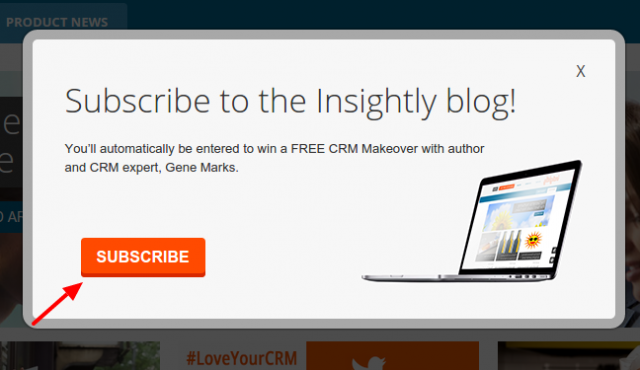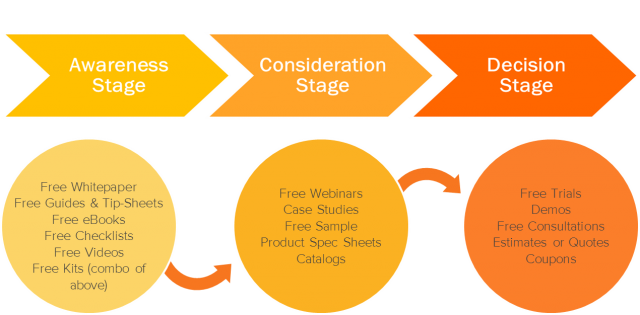This article was contributed Abhishek Talreja.
As a small business owner, one might get the notion that marketing automation is something far fetched. But, considering the cost and other benefits of automating marketing activities, small businesses can adapt the techniques of automation according to their requirements.

Marketing automation helps in simplifying:
- Customer relationship management
- Lead generation and nurturing
- Customer conversion and retention
According to Gartner, by 2020 85% of customers will manage their relationships without talking to a human.

Having an effective strategy for small business marketing automation will certainly be helpful in the long run.
Here are some useful tips from planning to executing a marketing automation strategy for your small business:
1. Build and manage an e-mail list
For marketing automation to deliver the best results for your business, you need to have an e-mail list that includes your prospects. One of the key ways to build opt-in lists is providing contact forms on website pages, blog and landing pages.
You can also get opt-ins using ebooks and whitepapers promoted on your site and social media channels, otherwise known as lead magnets.
Offline events and webinars are useful channels for building up your subscriber list. Your existing customers also need to be a part of your e-mail list.
Here is a use case of how you can capture customer data with automation:
|
Trigger |
Condition
|
Action |
|
A website visitor fills in the contact form |
He chooses a dropdown for inquiring a particular service say- ‘Web Development’ |
The CRM automatically updates the customer database under the section ‘Web Development Leads’ |
Here is another one:
|
Trigger |
Condition
|
Action |
|
The visitor reads a blog post on the website |
He has completed reading the post |
The visitor can see a popup that requests him to subscribe to the blog and submit his details |
Here is how Insightly, a CRM tool has created a subscription popup on its blog:

2. Segment your audiences
It is critical to create segments of your subscribers to ensure you are sending the right email marketing messages. Sending the same message to all your prospects will not be helpful.
Some of the key ways to segment your audiences include:
- Location
- Customer lifecycle
- Interests
- Lead Source
- Industry
- Activity
According to Gleanster: ‘78% of top performing marketers say list segmentation is one feature of marketing automation they can’t live without.’
3. Create Custom Messages
Once you have your customer segments in place, you need to decide on what marketing messages to send out to each. Customized and personalized campaigns would help you get the best results from automation.
For example, if a customer segment is looking for a particular product then it is essential to send them an email message that promotes that product. Your customized campaign messages include customized email templates, landing pages and Call-To-Action buttons. Perform an A/B test of the different types of messages and select the ones that are delivering better results.
Here is a use case of how you can do this:
|
Trigger |
Condition
|
Action |
|
A website visitor or a customer has not engaged with the website since a month |
Suppose the customer has visited the page of a particular product or service in the past |
The email tool would automatically send out a customized e-mailer to win this customer back |
4. Preference Mapping
Understanding the preferences of the consumer and sending out e-mailers related to what they would be interested in, can be very helpful.
While creating opt-ins give your buyers the options to choose the information they wish to receive.
5. E-mailer Timing
Optimizing the open and click rate of your campaign requires you to schedule your e-mailers at the appropriate time. Analyzing past campaigns will give a fair idea of the best days and time to plan your campaign.
6. Track User Activity
Numerous prospects are visiting your website on a daily basis. Tracking their activity helps you understand their preferences and create customized campaigns for them. You need to track the time your user is spending on your website pages. There is a host of details that you can capture like:
- Page wise activity of the user
- Type of content engagement
- Visits made on the conversion page
You can use heatmap tools to gather accurate data on the user activity. Here is a use case of how you can track user activity and create custom campaigns:
|
Trigger |
Condition
|
Action |
|
A website visitor has visited a particular section of the site and left without making a purchase |
The site visitor was browsing through a product section, say ‘Branded Jeans’ on your site. |
Customized messages with offers related to the ‘Branded Jeans’ are scheduled to this visitor. |
7. Understand Customer Lifecycle
Your customers and prospects are usually at varying stages in the buying cycle. Some are researching the product, while others are ready to make the purchase, and there are others who have bought and looking to buy again. By analyzing consumer activity, you can understand the stage they are in, at a particular time.
Customized messages based on customer lifecycle would help your clients and improve your conversion rate.

Source: Hubspot
8. Qualify Your Leads
While automating your marketing campaigns, you need to qualify your leads with the help of an appropriate lead scoring mechanism. Your sales team needs to decipher whether a prospect would benefit from your products and services. The higher the probability of a prospect to become a customer, the higher will be their score.
9. Create Triggers and Workflows
The activities that the users perform on your web pages can serve as triggers for creating workflows for your campaigns. For example, suppose a user visited the pricing page of your website. Now, this can be used as a trigger to automate a custom message that explains about the pricing or some of the product features in detail.
You need to define the key performance indicators of each of the workflows and measure the results accordingly.
Some use cases of triggers include:
- Following up with customers who abandoned the shopping cart
- Sending a welcome e-mail to new subscribers
Here is an example of a welcome mailer from Gliffy:

- Website visitors viewing specific content on the site
- Campaigns related to customer feedbacks
According to MarketingSherpa – ‘ The average open rate of welcome emails is 50%’. This is much more that the average open rate of other campaigns like newsletters and promos.’
According to Clickz – ‘ Birthday emailers can improve the rate of conversions by 60% over non-birthday emailers of the same offer.’
10. Follow Up Automation
Once you have qualified and prioritized your leads, they need to be followed up with appropriate messages. Creating automated and customized follow-up messages will save a lot of time and resources allocated to your sales process.
According to Hubspot – ‘nurtured leads always make 47% larger purchases than those who were not.’
11. Integrate Your Website with CRM Tool
You can easily capture the details of your prospects visiting the site, by integrating it with your CRM tool. Now you can do away with manual processes like collecting data and managing it.
The CRM tool also enables you to manage segments and lists according to business requirements. The integration helps in automating list building and centralizing customer data.
13. Automate Your Social Media Marketing
You can easily automate your social media marketing activities with tools like Hootsuite, Buffer and IFTT. Integrate your blog with social and automate sharing of blog posts on social channels like Facebook, Twitter, LinkedIn and the like.
Use social listening tools to get insights about your customers and customize your campaign messages accordingly.
14. Automate Marketing on Your Mobile App
The growth of the mobile device and mobile applications entails that marketing automation should be extended to this channel as well.
You can target application users with customized marketing messages according to their activity and preference. You can automate push notifications to app users to get them to take the desired action. Here is an example of a push notification:
GrubHub a food ordering app that engages with its customers by updating them about the delivery time of their order.

Image Source: Localytics
Customized campaigns based on the location of the user are catching up as well.
QR codes are an interesting option to get the user to participate in an activity using their mobile device and fill in their information.
These activities add to your database for automated campaigns and help in improving conversions and revenue from your mobile app. Segmenting the users and mapping their preferences is the key to your campaign success on the mobile device.
15. Analyze Results
As a small business, you have to analyses the results of your marketing activities on a periodic basis. For this, you must centralize all of your customer data and examine the rate of conversions on a weekly or a monthly basis.
This way you can decide on the channels which need to focused on and the ones which can be left out.
It is also important to engage with those customers who are loyal to your business and build on to the relationship.
You need to gauge consumer sentiment and re-do your campaign messages to suit customer requirements.
A small business needs to plan out the strategy for implementing marketing automation, more efficiently. You need to rope in mobile and social media channels along with E-mail and websites to create holistic campaign plans. Use consumer data and analytics to get the best out of your campaigns.
—
Abhishek Talreja is working as a Digital Marketing Manager with Enterprise Monkey. He has a keen interest in technology, and small business productivity. Enterprise Monkey helps SMEs and Not-For-Profits save time & money and increase revenue through automation, optimization & intelligence.
very helpful for my online business thanks
Thanks for sharing automatic business marketing….very nice….really helpful
HY!
Thanks for sharing…..very interesting and helpful in growing business online and promoting it
Couldn’t agree more, with so many great tools available these days. I know a lot of people may not even be aware of these tools, but even those who do are just to lazy (or busy) to try..
A little preparation will save a lot of time = money.
another fine article
Always looking at new ideas on how to improve small business marketing.
Hi Abhishek,
Nice write-up and tips to automate the small business marketing needs. Time is money and and you know when we put lot of efforts to manually all the work its pays off. But, things are changed now. There’s are lot of tools available to use them to reduce work load.
By building and maintaining an email list is good to convert them leads but you’ve described here very well by creating segment, tracking user activity, sending right emails to right peoples helps to get better results and leads.
Thanks for sharing the great piece on content.
Thank you for sharing such a wonderful article on business
The Article is really complete and amazing since even i have not even used all the tools mentioned. Small businesses should be open to use all the tools and new way of marketing considered as Growth hacking tools.
Very helpful tips. Marketing automation is a nice strategy for small businesses. Tools like GetResponse are quite easy to use for that. I use IFTTT and Buffer every day.